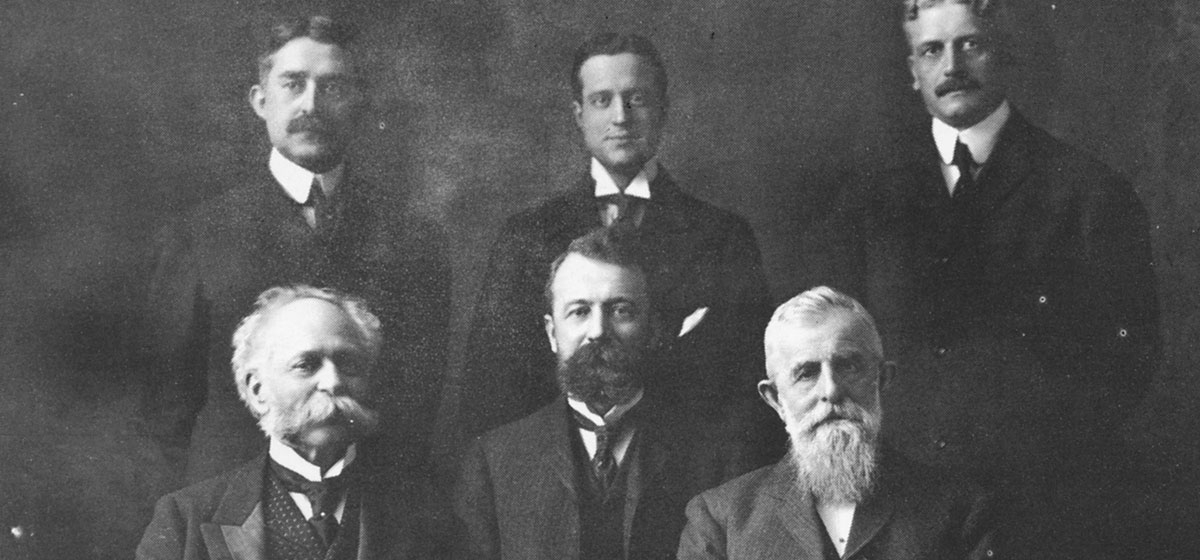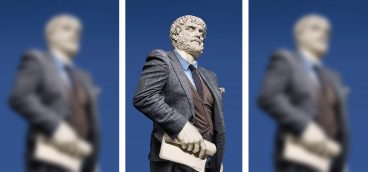
In the second half of the 19th century, as Pittsburgh emerged as one of America’s great cities, it did so on the back of heavy industry; steel predominantly, but also glass, oil and all manner of heavy machinery. Indeed, four of the five men novelist Edith Wharton dubbed the “Lords of Pittsburgh” built their fortunes on heavy industry—Carnegie, Frick, Mellon and Westinghouse.
H. J. Heinz was the odd man out. He built one of the nation’s first and greatest branded goods companies. And if you were to be marooned on a desert island with one of the five, Heinz would have been your best bet.
The beginning
Henry John Heinz was born in 1844, the first of nine children, in the Birmingham section of Pittsburgh’s South Side. He was nicknamed Harry. His mother came from Hesse-Darmstadt, his father from Rheinpfalz or Rhineland-Palatinate. When Harry was five, they moved to Sharpsburg, and the elder Heinz started a brick-making and contracting business.
The Heinz family was staunchly Lutheran. Anna Heinz enforced rigid church attendance upon her progeny at an early age. Harry and his young siblings were the subjects of Anna Heinz’s endless entreaties on the moral precepts of life. Among her favorites were “Always remember to place yourself in the other fellow’s shoes,” and “do all the good you can; do not live for yourself.” She struck fertile ground in the impressionable young Harry.
After school at the Lutheran pastorship, Heinz set to work at age eight in the family’s garden and in his father’s brick kiln. He immediately peddled excess produce to neighbors. By 10 he was allocated his own three-quarter-acre plot. Two years later he had quadrupled his acreage and drove his goods to an expanding market of local merchants with a horse and cart.
Heinz’s first move out of the fresh produce business was bottled horseradish. It set the course for his illustrious career. Most bottled goods then were served in green or brown bottles, the natural colorof glass. Other producers sometimes cheated their customers by hiding inferior ingredients such as leaves or wood chips in their opaque bottles. Young Heinz used clear glass bottles to display and promote the highest quality horseradish you could buy. Calling on the customer, Heinz might hold the bottle up to the light, saying, “See the quality in the whiteness of the root, unscrew the cap; taste the quality.”
In the floodtide of post-Civil Warprosperity, Heinz was tapping into the desire of the American housewife to pay a modest premium to be relieved of some of her onerous household chores. Quality ingredients were a must, but the consumer had to be convinced that the product was not only good, but better than any competing offering. The product also had to be promoted constantly. Branding and advertising would come later, but the idea was already there.
In 1869 Heinz married Sallie (Sarah) Sloan Young, who had emigrated from Northern Ireland. The business with partner L.C. Noble was growing rapidly. Over a two-year period, they expanded the product line to include celery sauce,pickled cucumbers, sauerkraut and vinegar. By 1875, annual capacity was 3,000 barrels of sauerkraut, 15,000 of pickles and 50,000 of vinegar. To feed this expanding maw they contracted for produce from 800 acres in Illinois.
The failure of Jay Cooke & Company in 1873 precipitated a financial crisis that caught many businesses in its undertow. It looked for a while as if Heinz & Noble might skate through on thin ice. It was not to be.
Heinz’s promotional abilities and entrepreneurial talents drove the company’s success, but also sowed the seeds of its failure. He tried to do too much too fast. Superintending the company’s finances, Heinz juggled money from one account to another, all to no avail. During Christmas week 1875, Heinz filed for personal bankruptcy. Assets were $110,000 and liabilities $160,000. The bankruptcy not only ruined Heinz, it engulfed his parents. Their house and furniture were levied against and advertised for sheriff’s sale. Twice he was arrested and released on bail. He was tried for fraud in January of 1876 and received a merciful acquittal.
Heinz had no money for food. He approached three local grocers with whom he had longstanding relationships; all three turned him down. His diary for Christmas Day 1875 shows his anguish. “I feel as though people were all putting us down because we are bankrupt… a man is nowhere without money… it is hard to lose trade, money, friends and reputation and even parents in trouble… I am more blamed because I did the financing.”
Three factors favored Heinz’s recovery: his ability and ambition plus his young age (32). He was badly bent but not broken. He again returned to family. His wife, his brother John and his cousin Frederick jointly raised $3,000. Sarah Heinz held 50 percent of the stock in the newly named FJ Heinz Company, launched Feb. 14, 1876. Heinz was paid $125 to run the company. As he called on the trade, he carried a small notepad marked M. O. It stood for “Moral Obligations” and listed each Heinz Noble creditor and the debt owed.
The road back
Most industrialists aren’t diarists. Heinz was the exception. Observations on his recovery from bankruptcy and his building of a major industrial enterprise are recorded in 18 slender volumes covering 1875-1894. Through his quotidian musings on life, family, business and religion, the reader gleans much insight into the way driving ambition and a deep sense of humanity are so finely balanced in this remarkable man.
“May 17, 1878: George McNally was caught in the belts of the mustard mill at 6 p.m. and all his clothes were ripped from his back, and yet not much hurt. God be praised for his mercy.”
“May 25: Bought a blue business suit today, $17, trying to save.”
“July 1: Had a chat with Mr. Craig (Grocer), a creditor of H. N. & Co. Told him… that my moral obligation to him was 100 cents on the dollar.”
“November 10: I enjoyed this day very much. Sunday School at 9:15. Met my class.All well. Then to Christ Church to hear Dr. Morgan and to Mission Sunday School at 2 p.m. To class at 6:15. Then to hear Reverend E. M. Wood at 7:30 p.m. at Christ M. E. Church. So on the whole, my day was all taken up except about two hours which I enjoyed with my family.”
In July of 1877, all hell broke loose in Pittsburgh. The Pennsylvania Railroad cut wages by 10 percent. The men struck, and violence ensued. National Guard units were sent from Philadelphia. Twenty-nine strikers and guardsmen were killed, and property damage was in the millions. It was the worst labor unrest in Pittsburgh until the Homestead strike. These events left a searing and enduring impression on the mind of Heinz. It would culminate in the Heinz factory system, which eliminated the need for violence through enlightened labor management practices. In 1877 it was little more than a dream. In 1900 it was reality.
The rapid growth of the company and subsequent recovery of Henry Heinz’s finances were set against a favorable backdrop of changing American eating habits. Prior to 1870, what you ate was largely what you grew or what your neighbors grew. Fresh fruits and vegetables were available only during the growing season. In winter, salads were confined to cucumbers and pickles. The homemaker’s tasks wereonerous, extending far beyond cooking. She, in effect, operated a small food preparation factory inside her home. She ground coffee beans, stuffed sausage, churned butter and pressed cheese. A revolution in the form of transportation (rail), refrigeration and vacuum-sealed cans and jars was gathering momentum.
Heinz was among a small group of visionaries in the food processing business who capitalized on these innovative trends. Heinz was far more than a canner of fruits and vegetables. He was a processor of “reciped products” ready to eat right from the jar. Heinz’s “57 varieties” freed the housewife from some of her mind-numbing domestic duties. He removed a part of her little cottage factory and placed it in an industrial setting.
The key to all this was the preservation of food in sealed glass containers. By heating them 240 degrees, the containers were sterilized and microorganisms destroyed. Among the reasons Heinz succeeded spectacularly where most others failed or languished was his extended definition of that crucial word — “quality.” Heinz moved the concept of quality upstream from the factory to the field. He bred improved varieties of seeds and contracted with growers to produce the highest quality raw ingredients specifically for his products. Quality was emphasized and monitored throughout the entire process.
By 1879, Heinz had reached his goal of solvency one year ahead of schedule. The first half of the 1880s saw smooth sailing.Although the company was still small, the Heinz diaries of those years are revealing. 1879: “It takes one dress suit every two years to do me. Then I wear it for every day.” On a church social: “If I go I treat others, or I can’t go… I never could enjoy myself unless I could make others comfortable.” Heinz loved the horses that pulled his sales wagon. 1880: “I saw a span of spotted mares, well matched, and inside of a half hour had tried and bought them.They will make a lovely span to advertise.” Drinking was an ongoing problem. 1882: “I had all the wagon salesmen together in my room… a talk on temperance.”
Early in 1884, Heinz bought a foundry building for use as a vinegar factory. It was destined to be the core of the large North Side complex he began in 1890. It continues in use today. Momentum was building; results for 1884 showed sales of $381,000 — $7.6 million in today’s dollars and profits of $43,860 ($877,200). At long last, on Feb. 3, 1885, Heinz’s application for release from bankruptcy was upheld. “Thank God I am a free man,” he wrote.
With the birth of his son Clifford in 1884, his family was completed. Irene had been born in 1871, Clarence in 1873 and Howard Covode Heinz in 1877. In 1883 one important addition to the close-knit Heinz family occurred when Sebastian Mueller, who had just been named general manager of manufacturing, married Henry Heinz’s sister Elizabeth. The two were first cousins. The impeccably attired Mueller played a critical role in the Heinz enterprise for the next 50 years. Sebastian and Elizabeth Mueller tragically lost all three of theirchildren early in life. They bequeathed their considerable fortune to Eden Hall Farm, a 375-acre recreation facility 20 miles north of Pittsburgh for use by current and former H. J. Heinz female employees. Though the farm is now closed, Eden Hall exists today as a $200 million foundation doing good works in the city of Pittsburgh.
Advertising genius
Heinz proudly displayed his array of products at the 1893 Columbian Exposition in Chicago — the “White City” electrified by Pittsburgh’s own George Westinghouse. The McKim, Mead & White-designed agricultural building housing the Heinz exhibit covered 19 acres. Unfortunately for H. J. Heinz and its U.S. competitors, they were located one floor up from the main floor, which had been given to foreign exhibitors and state agricultural exhibits.Heinz had more space than any other exhibitor. It was done in antique oak and attended by a bevy of attractive young hostesses. But traffic was sparse. Sizing up the situation, Heinz responded immediately. He hired an army of young boys who passed out thousands of small, white baggage-claim-sized cards promising the bearer a free souvenir upon presentation at the Heinz exhibit.
The second floor soon groaned with a swarm of souvenir seekers. There they saw a wide array of art objects and antiques while feasting on all manner of H. J. Heinz offerings, and received the widely promised free souvenir, “a green gutta-percha pickle one and one quarter inches long, bearing the name Heinz.” The sheer novelty of the promotion made it a home run. Fair officials had to summon local police for crowd control. Foreign exhibitors on the first floor cried foul. Heinz’s neighboring domestic producers were so delighted with the surging traffic that they hosted a dinner in his honor. Heinz’s promotional coupd’état, along with those gutta-percha (later plastic) pickles, became an essential part of the Heinz legend. The Saturday Evening Post called the Heinz pickle “one of the most famous giveaways in merchandising history.”
Heinz was the first industrialist to promote his products by inviting the public to tour his model plant operation. By the turn of the century more than 20,000 visitors annually trooped through the Heinz complex. Highlights of the tour included the stables, can factory, time office and the baked beans building. All tours concluded with a lecture in the company auditorium, and of course, a memento of one’s visit — the ubiquitous plastic pickle. (The author vividly remembers his Conneaut Lake grade school visit in 1951 and his little greenpickle).
Heinz had an eye for promotion and advertising unequaled by any of his competitors. He loved horses but exploited their drawing power to the fullest extent. They were all jet black, of a certain size, and outfitted with lustrous brass trimmings. They pulled white wagons with green trimmings. Had the name Heinz not been easily seen from all sides, few would have doubted the provenance of this handsome equipage. Almost every animal selected for the Heinz delivery elite was personally inspected by either H. J. or Sebastian Mueller.
There was nothing very subtle about Heinz’s advertising. He advertised early; he advertised late; he advertised often. From the beginning he employed “point of sale” material in the stores where his goods were sold: calendars, souvenirs, books and stamped-out pickle cards. You name it, he used it. There was hardly a streetcar in America without a Heinz color card and a four-line verse. Large signs were spotted along almost every railroad mainline. Ten prominent hillsides, including a cliff over San Francisco Bay, proudly blossomed with “Heinz 57.” The company owned over 400 freight cars, each emblazoned with the name Heinz.
Electrical outdoor signs were just beginning to be used, and Heinz was a pioneer. He personally designed New York’s first large electric sign at 23rd Street and Fifth Avenue. It was six stories high and topped by a giant green pickle 40 feet long bearing the name Heinz. Beneath it the viewer read “57 Good Things for the Table exhibited at the Heinz Pier.”
Heinz personally seized upon the 57 Varieties slogan. While riding a New York elevated one day, he glanced at the wall and saw an advertisement for “21 styles of shoes.” For some unknown reason he seized upon the number 57. As Heinz recounted, “I jumped off the train at the 28th Street station and began the work of laying out my advertising plans. Within a week, the sign of the green pickle with the ‘57 Varieties’ was appearing in newspapers, on billboards, signboards and everywhere else I could find a place to stick it.” What cut Heinz out from the herd? Those lines say it all. Heinz excluded only one medium in his all out advertising assault. He refused to advertise in the Sunday papers.
The crown jewel of Heinz’s advertising and promotional efforts was the Heinz Ocean Pier at Atlantic City. In 1898, Heinz bought a pier at the foot of Massachusetts Avenue. It had a land-side building framed by large pickles and a seaside exhibition hall some 300 feet out into the ocean.Inside the hall were paintings, bronzes, tapestries and curios of all kinds. The centerpiece was a booth with thousands of Heinz products artistically arranged in revolving pyramids. A lecture was given with slides providing the visitor with avirtual tour of the Heinz Pittsburgh plant. Everything was free. Unique among Atlantic City’s several piers, the Heinz Pier was open year-round, but not on Sundays. This “crystal palace by the sea” had a 46-year run from 1898 until 1944.
The Heinz model factory
By 1900, the Heinz complex of 17 buildings on Pittsburgh’s North Side was a small industrial city. It was a happy city. Its denizens were primarily female. In those days office clerks and functionaries were mostly men. Hours were long: 7 a.m. to 5:40 p.m., six days a week. Wages were modest, but working conditions were very good. The Heinz Girl began each day in a freshly laundered uniform. She could enjoy her modest leisure time on a rooftop garden, in the reading room, swimming, or in the gymnasium. Classes in a variety of self-improvement activities included dressmaking, drawing and even singing lessons. For new immigrants, citizenship instruction was offered.
In its day, the Heinz factory system was a spectacular achievement, and Heinz’s fingerprints were on every part of it. Always the promoter, Heinz was not bashful about publicizing his model factory. He willingly met the press to answer questions about his signal achievements in employee relations. Asked if he got fair value for his expenditures, Heinz said: “I have never given that side of the matter any thought.” This, of course, was somewhat disingenuous and when pressed on thematter Heinz replied: “Very well then, if you don’t like the sentiment that attaches to the plan, I want you to distinctly understand that it is good business aswell. It pays.” Heinz was no Utopian sentimentalist; he had ever in mind the endgame. Not surprisingly, there was no labor trouble at Heinz, and unionization came only in the sweeping organization drives of the 1930s.
The pickle king
By 1900, Heinz had built the nation’s largest packaged foods company. The firm’s market share rankings in leading product categories was impressive by any measure. It held the largest share in pickles, vinegar, sauerkraut, horseradish and most importantly, its future flagship product, ketchup. It was second in mustard and fourth in olives. H. J. Heinz employed 2,800 people, of whom 400 were salesmen. Behind this industrial phalanx stood an army of 20,000 who grew Heinz-contracted crops on 16,000 acres. Aside from a couple of minor acquisitions, Heinz’s growth was organic.
In 1892, Heinz purchased the Hopkins mansion, Greenlawn, in the Point Breeze section of Pittsburgh. His neighbors included George Westinghouse, Henry Clay Frick, R. B. Mellon, a host of Carnegie partners and Carnegie’s mother. Greenlawn occupied a full block on Penn Avenue between Lang and Murtland Avenues. It was more than a mansion; it was a museum and a conservatory. By 1915, it had some 5,000 possessions covering a bewildering variety of objects: miniatures, antique watches, glass, pottery, jewelry and silver, to name a few. He had a full-time curator. He built a full-blown conservatory consisting of 10 greenhouses; almost a small private Phipps Conservatory. The museum and the conservatory were closely intertwined with his constant travels.
Heinz lost his wife Sarah in 1894; she died of pneumonia at 51. He never remarried. In 1885, his two eldest sons Clarence (12) and Howard (8) had begun part-time work in the Heinz office. Clarence, plagued by bad health, was not cut out for a business life and retired from the company in 1914. Howard more than measured up to his father’s high expectations and succeeded him as president upon his death in 1919.
Heinz had been active in Sunday School from childhood as a pupil, teacher, superintendent and director of the county association. In 1906 he succeeded his friend John Wanamaker (the Philadelphia department store king) as the president of the Pennsylvania State Sabbath School Association. He also served on the executive committees of the World and International Sunday School Associations.
During the half century from the Civil War to World War I, religion had a social pervasiveness far different from the sharp political thrust of today’s religious right. Religion as a social instrument subtly wrapped its tendrils around the social life of the community. Indeed, to be a member of the community was virtually synonymous with being an active member of a community church. And Heinz’s commitment in time and money to hisreligious community was tremendous. He understood the Sunday School movement to be “the world’s greatest living force for character building and good citizenship.” The most powerful force that drew Heinz into his Sunday School work was his love of children. From early on he had an innate understanding of children. He responded to them, and they reciprocated. A Heinz company director once said: “He loved children more than any man I knew. I don’t think he ever saw a child without giving it something.”
Under Howard and Sebastian Mueller, the Heinz Company was a well run and expanding enterprise. Henry Heinz generally concurred with them, but not always. He occasionally interfered — not in matters of major importance, but on minor items that happened to seize his attention. Unsatisfied with the company’s California sales, he urged more local advertising. He wrote to Howard, “I now insist that weact. I urged this before I left home but cannot find a single advertisement in the magazines. Are you asleep? Read this to the advertising department.” And then in a repentant mood a few days later, “I am preaching a little this morning because I feel deeply. If I love you I must speak the truth and say the things that will help you.”
Heinz liked new things. In 1911, when visiting Heinz’s operations in Northern Indiana, he went for an airplane ride with aviation pioneer Glenn Curtis. They covered (appropriately) 57 miles in one hour and 15 minutes. His wisdom in letting goof the business provides a sharp contrast to the monumental yet tyrannical figure of Henry Ford, who browbeat and bullied his only son Edsel to an early grave in 1943.
Heinz was always slender and dapper. Most people try to lose weight; Heinz tried to gain it during his annual trip to the spa at Bad Kissingen. In notes on his stay Heinz observed, “All puddings and vegetables contain plenty of butter. I manage to eat one-third of a pound of butter per day.”His trip was not a complete success. He gained only three and one-half pounds in10 days.
Henry J. Heinz died on May 14, 1919, six months short of his 75th birthday. He left an estate of $4 million ($80 million in today’s dollars). Major bequests were $250,000 to the University of Pittsburgh and $300,000 to various Sunday School associations. He offered Greenlawn’s conservatory to the City of Pittsburgh.The city declined the offer and a few years later the entire site was razed and subdivided. The balance of the estate was divided in equal portions among Irene, Howard and Clifford. Clarence had been separately provided for.
Among Edith Wharton’s “Lords of Pittsburgh,” the Heinz fortune was by far the smallest. But through the careful stewardship of Howard, who succeeded his father as president and held the office until his death in 1941, and his younger brother Clifford, the Heinz legacy grew through their bequests into the $1.5 billion Heinz Endowments. How did relatively little turn into so much? H. J. Heinz built a superior company in a good industry. Its fortunes prospered, and its stock compounded more rapidly than the heavy industrial holdings of his peers.
Fortune-building often takes a terrible toll on the builder, his family, former friends and weaker competitors. But no matter how hard one sands it, the unvarnished truth about Heinz remains the same. He led a balanced life. He had a human touch. His story is about good products produced by a good man.





